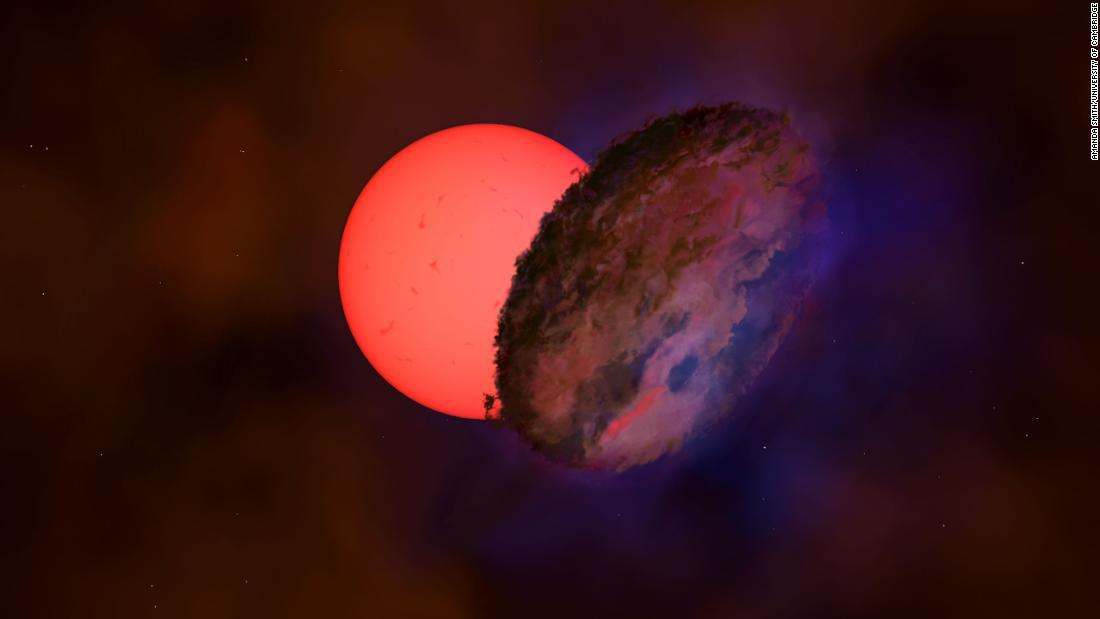(CNN) – According to new observations by astronomers, a large star will shine like a star lighthouse near the center of our Milky Way. This star is more than 25,000 light years from Earth.
This star, known as VVV-VIT-08, is dim and has almost disappeared from view during astronomers’ observation.
It is not uncommon for the brightness factor of a star to change. Some stars pulse, or one star within a star pair, called a binary, can be eclipsed by another star. But it is incredibly rare for a star to fade and shine again, i.e., flicker.
Observing this star led researchers to believe it may belong to a new class: a “glowing giant” binary star system. In this class there are giant stars a hundred times larger than our Sun, which are dwarfed by an invisible companion every few decades, be they a planet or another star.
This mate may have been surrounded by a disk of material that obscured the giant star, causing a flickering pattern that astronomers observe.

This is the idea of the artist VVV-VIT-08, a giant “glowing” star near the center of the Milky Way.
The study was published in the Newsletter on Friday. Monthly Announcements of the Royal Astronomical Society.
The center of our galaxy is a dense region that contains an amazing black hole, super clusters of stars, gas streams, and magnetic fields.
“It’s surprising that we have rarely observed a large, elongated dark object pass between us and a distant star, and we can only guess what it looks like,” said Sergei Kobozov, co-author of the study and professor of observational astronomy. University of Edinburgh., This is a report.
At first, researchers speculated that an unknown dark object might have passed in front of the giant star, but this would only be possible if there were a large number of these objects in the galaxy.
Studying other unique star systems, such as giant stars glowing dark or showing this flicker pattern, helped researchers determine if there might be a new type of glowing giant star to explore. So far, there seem to be six such systems.
The star system in this study is called “Vista variables in Via Lactia” or VVV. The project, which uses the Vista telescope at the European Southern Laboratory in Chile, has been observing one billion stars for nearly a decade and how their brightness varies.
“Every time we see variable stars that do not fit into any set, we call them ‘what-is-it’ objects or ‘VIT’,” explained Philip Lucas, project leader at Vista and a university professor. Hertfordshire., This is a statement. ‘We don’t know how these glowing giants came to be. After many years of planning and data collection it is exciting to see these VVV discoveries.
The star’s blur was detected using an optical gravity lens experiment called OGLE, a celestial study led by the University of Warsaw. Data sets from both studies showed that the star was equally dark in infrared and visible light.
Astronomers will be looking for more glowing giant star systems to learn more about them.
“There’s still a lot to discover, but the challenge now is to find out what the hidden comrades are and how they were surrounded by disks, despite being surrounded by the giant star so far,” said Lee Lee Smith, lead discoverer and research partner. In a report, at the Astronomical Institute of the University of Cambridge. “In doing so, we can learn something new about how these types of systems are formed.”





:quality(85)/cloudfront-us-east-1.images.arcpublishing.com/infobae/KTKFKR763RBZ5BDQZJ36S5QUHM.jpg)